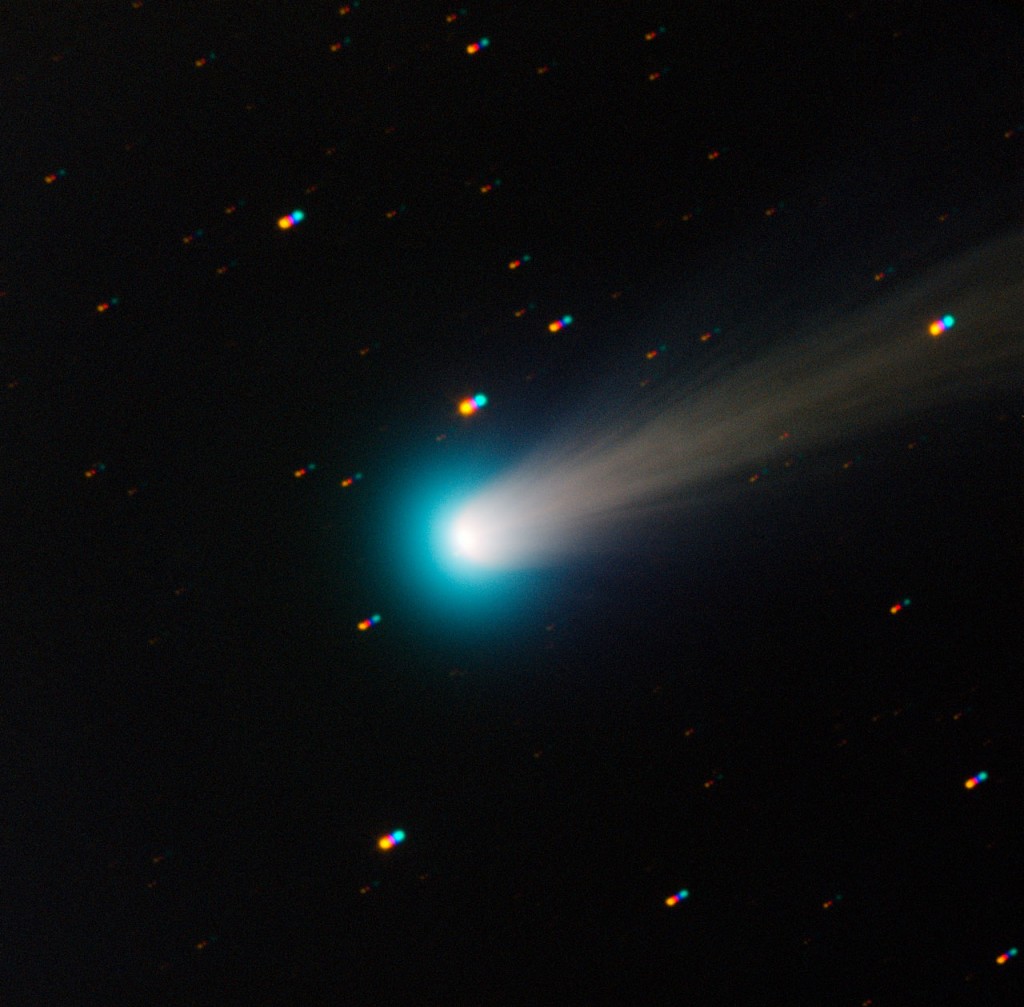
Credit: TRAPPIST/E. Jehin/ESO
Questa nuova immagine della cometa C/2012 S1 (ISON) è stata scattata con il telescopio nazionale TRAPPIST di La Silla dell’ESO, la mattina di Venerdì 15 novembre 2013. La Cometa ISON è stata avvistata nei nostri cieli nel settembre 2012, e vedrà il suo massimo avvicinamento al Sole a fine del corrente mese di novembre 2013.
TRAPPIST ha monitorato la Cometa ISON da metà ottobre utilizzando filtri a banda larga come quelli usati per questa immagine. Sono stati utilizzati anche speciali filtri a banda stretta che isolano l’emissione dei vari gas, permettendo agli astronomi di contare quali e quante diverse molecole vengono rilasciate dalla cometa. ISON è stata abbastanza tranquilla fino al 1 ° novembre 2013 quando si è verificato un primo aumento della luminosità grazie alla raddoppiata quantità di gas emessi dalla stessa cometa. Il 13 novembre , poco prima dello scatto di questa immagine, una seconda esplosione ha interessato la grande cometa, aumentando la sua visibilità tanto che ora è abbastanza brillante da essere vista con un buon binocolo da una postazione sufficientemente buia nel cielo di prima mattina guardando verso oriente. Nelle ultime due notti la cometa si è stabilizzata al suo nuovo livello di attività. Queste esplosioni sono state causate dal calore intenso del sole che raggiunge il ghiaccio nel piccolo nucleo della cometa come la stessa si avvicina alla nostra stella, provocando una sublimazione nel suo cuore ghiacciato e sprigionando così grandi quantità di polvere e di gas nello spazio. Con il passare dei giorni ISON accorcia i tempi con il suo approccio ravvicinato al Sole previsto per il 28 novembre (a solo 1,2 milioni di chilometri dalla sua superficie – un po ‘meno rispetto al diametro del Sole), il cui calore provocherà ancora più conseguenze al nucleo di ghiaccio. Tuttavia, potrebbe anche succedere che l’intero nucleo possa rompersi in piccoli frammenti, che potrebbe farla completamente evaporare nel momento in cui la cometa si allontanerà dal calore intenso del sole. Se ISON sopravviverà al suo passaggio vicino al Sole, potrebbe quindi diventare spettacolarmente luminosa nel cielo del mattino. L’immagine è una composizione di quattro esposizioni di 30 secondi attraverso differenti filtri blu, verde, rosso e altri nel vicino infrarosso. Mentre la cometa si sposta davanti alle stelle nello sfondo, queste appaiono come più punti colorati. TRAPPIST si dedica allo studio di sistemi planetari attraverso due approcci: l’ individuazione e la caratterizzazione di pianeti situati al di fuori del sistema solare (esopianeti), e lo studio delle comete che orbitano intorno al sole. Il telescopio nazionale di 60 cm è gestito da una sala di controllo a Liegi, in Belgio, a 12 000 km di distanza.
This new view of Comet C/2012 S1 (ISON) was taken with the TRAPPIST national telescope at ESO’s La Silla Observatory on the morning of Friday 15 November 2013. Comet ISON was first spotted in our skies in September 2012, and will make its closest approach to the Sun in late November 2013.
TRAPPIST has been monitoring comet ISON since mid-October, using broad-band filters like those used in this image. It has also been using special narrow-band filters which isolate the emission of various gases, allowing astronomers to count how many molecules of each type are released by the comet. Comet ISON was fairly quiet until 1 November 2013, when a first outburst doubled the amount of gas emitted by the comet. On 13 November, just before this image was taken, a second giant outburst shook the comet, increasing its activity by a factor of ten. It is now bright enough to be seen with a good pair of binoculars from a dark site, in the morning skies towards the East. Over the past couple of nights, the comet has stabilised at its new level of activity. These outbursts were caused by the intense heat of the Sun reaching ice in the tiny nucleus of the comet as it zooms toward the Sun, causing the ice to sublimate and throwing large amounts of dust and gas into space. By the time ISON makes its closest approach to the Sun on 28 November (at only 1.2 million kilometres from its surface — just a little less than the diameter of the Sun!), the heat will cause even more ice to sublimate. However, it could also break the whole nucleus down into small fragments, which would completely evaporate by the time the comet moves away from the Sun’s intense heat. If ISON survives its passage near the Sun, it could then become spectacularly bright in the morning sky. The image is a composite of four different 30-second exposures through blue, green, red, and near-infrared filters. As the comet moved in front of the background stars, these appear as multiple coloured dots. TRAPPIST (TRAnsiting Planets and PlanetesImals Small Telescope) is devoted to the study of planetary systems through two approaches: the detection and characterisation of planets located outside the Solar System (exoplanets), and the study of comets orbiting around the Sun. The 60-cm national telescope is operated from a control room in Liège, Belgium, 12 000 km away.
Source/Continue reading → ESO.org





















